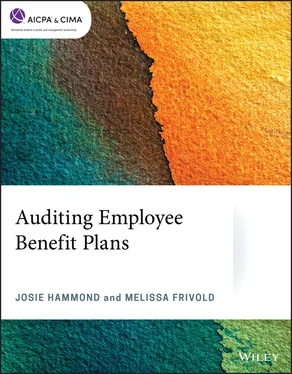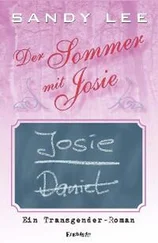Josie Hammond - Auditing Employee Benefit Plans
Здесь есть возможность читать онлайн «Josie Hammond - Auditing Employee Benefit Plans» — ознакомительный отрывок электронной книги совершенно бесплатно, а после прочтения отрывка купить полную версию. В некоторых случаях можно слушать аудио, скачать через торрент в формате fb2 и присутствует краткое содержание. Жанр: unrecognised, на английском языке. Описание произведения, (предисловие) а так же отзывы посетителей доступны на портале библиотеки ЛибКат.
- Название:Auditing Employee Benefit Plans
- Автор:
- Жанр:
- Год:неизвестен
- ISBN:нет данных
- Рейтинг книги:4 / 5. Голосов: 1
-
Избранное:Добавить в избранное
- Отзывы:
-
Ваша оценка:
- 80
- 1
- 2
- 3
- 4
- 5
Auditing Employee Benefit Plans: краткое содержание, описание и аннотация
Предлагаем к чтению аннотацию, описание, краткое содержание или предисловие (зависит от того, что написал сам автор книги «Auditing Employee Benefit Plans»). Если вы не нашли необходимую информацию о книге — напишите в комментариях, мы постараемся отыскать её.
FASB ASU 2017-06, which significantly impacted master trust accounting, reporting and disclosures for employee benefit plans PCAOB adopted AS 3101 in 2017 which resulted in significant changes to the existing auditor's report. New insert for SAS No. 136, Forming an Opinion and Reporting on Financial Statements of Employee Benefit Plans Subject to ERISA
Auditing Employee Benefit Plans — читать онлайн ознакомительный отрывок
Ниже представлен текст книги, разбитый по страницам. Система сохранения места последней прочитанной страницы, позволяет с удобством читать онлайн бесплатно книгу «Auditing Employee Benefit Plans», без необходимости каждый раз заново искать на чём Вы остановились. Поставьте закладку, и сможете в любой момент перейти на страницу, на которой закончили чтение.
Интервал:
Закладка:
Single, multi-, and multiple employer plans
Form 5500 defines kinds of filers as different types of plan entities.
A single employer plan is a plan maintained by one employer or one employee organization. A plan of a controlled group of corporations or common control employers is considered a single employer plan for ERISA purposes. This exists when one plan is maintained for a controlled group of corporations, a group of trades or businesses under common control, or an affiliated service group. If a member of any of these groups maintains a plan that does not involve other group members, then a separate Form 5500 is filed as a single employer plan.
A plan is a multiemployer plan if
more than one employer is required to contribute;
the plan is maintained pursuant to one or more collective bargaining agreements between one or more employee organizations and more than one employer; and
an election under IRC Section 414(f)(5) and ERISA Section 3(37)(E) has not been made or has been revoked as permitted by the Pension Protection Act of 2006. The plan sponsor of a multiemployer plan, with whom ultimate administrative responsibility rests, is a joint employer or union board of trustees.
Participating employers do not file individually for these plans.
Multiemployer plans are unique in that assets contributed by one employer may be used to pay benefits of another participating employer. If a participating employer fails to make its required contributions, the unfunded obligation may be borne by the remaining participating employers. In addition, an employer that stops participating in the plan is generally required to pay a withdrawal liability.
Multiple employer plans are plans that are maintained by more than one employer but not treated as a multiemployer plan. Multiple employer plans are generally not collectively bargained and are intended to allow participating employers to pool their assets for investment purposes and to reduce the costs of plan administration. A multiple employer plan maintains separate accounts for each employer so that contributions provide benefits only for employees of that contributing employer.
If a multiple employer plan (other) provides welfare benefits, it is sometimes characterized as a multiple-employer-welfare-arrangement (MEWA). A single Form 5500 can be filed by the MEWA for all the plans in the arrangement.
Multiemployer and multiple employer plans are subject to different accounting requirements that are outside the scope of this course. The AICPA’s Audit & Accounting Guide Employee Benefit Plans provides specific guidance.
There were new developments with respect to multiple employer plans during 2012 12. The elements of this change are too detailed for a basic course. The auditor, however, should be warned that multiple employer plans which filed a single Form 5500 in prior years may be required to file multiple reports for each participating employer under this revised interpretation.
Unrelated business income tax
Though employee benefit plans are generally exempt from Federal income tax, they can still be exposed to income tax in certain situations. This tax is reported on Form 990-T. If the income is significant, the plan must also file quarterly tax payments.
If the plan invests in a pass-through entity – a partnership or S corporation – and that entity is engaged in a trade or business (as opposed to simply investment activity), then the plan will report unrelated business income on its share of any pass-through income. ESOPs are exempt from that tax to the extent that the pass-through income is associated with “qualifying employer securities” as defined in IRC Section 409(l) .
Another common source of unrelated business income arises when a plan incurs debt to acquire an investment. For example, if securities are acquired by a plan on margin, unrelated business income tax may apply. There are exemptions from this rule relating to certain debt-financed real estate rental investments and leveraged ESOPs. This rule becomes complicated when the plan invests in a pass-through entity. That entity may generate investment income, but if it uses debt financing to generate that income, the plan could be subject to unrelated business income tax.
Audit procedures could include inquiring of plan trustees regarding their controls over the determination of unrelated business income, receipt of any income tax reports – Schedules K-1 for pass-through entity investments or other steps to manage this area. A properly completed Schedule K-1 should acknowledge the existence of unrelated business income by including the amount in Box 20 and designating it with a Code V. The plan, as a partner, is required to notify the entity of its tax-exempt status. Thus, the absence of the Code V designation may not be determinative if the plan never notified the entity that it was tax-exempt or if the preparer is unfamiliar with the importance of the coding.
Finally, welfare benefit plans may be subject to a special form of unrelated business income tax, which is incurred only if the plan’s assets exceed certain funding limits. These rules are found in IRC Sections 419 and 419A.
In the event a benefit plan has significant exposure to this tax, the auditor will also need to assess the effect of any uncertain tax positions under FASB ASC 740, Income Taxes . As described earlier in this chapter, the plan’s tax-exempt status is also a tax position that must be considered under this standard. Other tax positions would relate to the status of income as subject to unrelated business income tax and where the income is subject to unrelated business income tax, the determination of the amount and timing of items of income or expense. This is not merely a Federal tax consideration. Many states also impose this tax.
Understanding the plan under audit
The benefit and plan structure intended by the plan sponsor must be practiced in form. If more than one type of benefit is offered under the same plan, then the plan should be written accordingly. If benefits are to be offered under separate plans, it should be remembered that the reporting and filing requirements apply to each plan. Benefits do not stand-alone. They must be contained within a plan. The audit requirement, like the Form 5500 filing, is based on plan definition, with some exceptions, covered in the following exhibit under plan entities. Generally, only one plan at a time, pension or welfare, can be covered by a Form 5500. Proper reporting requires a complete understanding of the plan and benefit structure.
The following 3 exhibits outline unique audit considerations by plan type, tax considerations in an employee benefit plan audit and provide a quick reference chart for Form 5500.
 Exhibit 1-2 Unique audit considerations by plan type
Exhibit 1-2 Unique audit considerations by plan type
| Feature | Money purchase | Profit-sharing | 401(k) | SIMPLE 401(k) | 403(b) |
| Restrictions on adopting? | Generally, none. | Generally, none. | Generally, none. | Available only to employers with 100 or fewer employees earning $5,000 in previous year. | Limited to public schools, charitable organizations and churches |
| Can an employer maintain other qualified plans? | Yes. | Yes. | Yes. | No. | Yes. |
| Minimum age or service requirement? | Age 21, up to 2 years’ service may be imposed. | Age 21, up to 2 years’ service may be imposed. | Age 21, up to 2 years’ service may be imposed. No more than one year of service may be required for employee deferrals. | Same as 401(k). | Same as 401(k) for employer contributions. Universal availability for salary deferrals. |
| Vesting? | Yes. Graduated or cliff vesting allowed. | Yes. Graduated or cliff vesting allowed. | Yes. Employer contributions; graduated or cliff vesting allowed. Employee contributions are 100 percent vested. | 100 percent immediate vesting. | Same as 401(k). |
| Annual contributions required? | Yes. Mandatory as set forth in the plan. | No discretionary. | No discretionary. | Yes, for SIMPLE feature. To qualify as a SIMPLE 401(k) and avoid the ADP testing, an employer contribution is required. | Same as 401(k). |
| Limit on deductible employer contributions? | Maximum 25 percent of compensation, up to Section 415 dollar limit: $56,000 for 2019, $55,000 for 2018, $54,000 for 2017, $53,000 for 2015 and 2016. | Same. | Same. | Limited to required matching or nonelective contributions. | Same generally, some attributes that allow for higher limits. |
| Top-heavy rules apply? | Yes. | Yes. | Yes. | No. | Yes to employer contributions. |
| Nondiscriminat ion rules apply? | Yes. | Yes. | Yes. Special rules apply to employee deferrals. | No. | Yes. To employer contributions. |
| Employee deferrals allowed? | No. | No. | Yes. Employee deferrals limited to lesser of 100 percent of compensation (net of deferrals). | Yes. Employee deferrals are limited. | Same as 401(k). |
| Limit on employee deferrals? | N/A | N/A | $19, 000 for 2019, $18,500 for 2018, $18,000 for 2015, 2016, and 2017. | $13,000 for 2019, $12,500 for 2015, 2016, 2017, and 2018. | Same as 401(k). |
| Permitted disparity allowed? | Yes. | Yes. | Yes. | No. | Yes. For employer contribution. |
| Minimum coverage rules apply? | Yes. | Yes. | Yes. | Yes. | Yes. For employer contribution. |
| Annual additional limit of IRC Sec. 415 apply? | Yes. | Yes. | Yes. | Yes. | Yes. For employer contribution. |
| Participant loans allowed? | Yes, if specified in plan document. Subject to IRS limitations. | Yes, if specified in plan document. Subject to IRS limitations. | Yes, if specified in plan document. Subject to IRS limitations. | Yes, if specified in plan document. Subject to IRS limitations. | Yes, if specified in plan document. Subject to IRS limitations. |
| Rollovers to other plans allowed? 13 | Yes. | Yes. | Yes. | Yes. | Yes. |
| Annual report (Form 5500 series) required? | Yes, unless one-participant/$250,000 exception is met. | Yes, unless one-participant/$250,000 exception is met. | Yes, unless one-participant/$250,000 exception is met. | Yes. | Yes. |
| Age 50+ Catch Up contribution permitted? | No. | No. | Yes, $6,000 for 2015 through 2019. | Yes, $3,000 for 2015 through 2019. | Yes. Same as 401(k). |
 Exhibit 1-3 Tax considerations in an employee benefit plan audit
Exhibit 1-3 Tax considerations in an employee benefit plan audit
Интервал:
Закладка:
Похожие книги на «Auditing Employee Benefit Plans»
Представляем Вашему вниманию похожие книги на «Auditing Employee Benefit Plans» списком для выбора. Мы отобрали схожую по названию и смыслу литературу в надежде предоставить читателям больше вариантов отыскать новые, интересные, ещё непрочитанные произведения.
Обсуждение, отзывы о книге «Auditing Employee Benefit Plans» и просто собственные мнения читателей. Оставьте ваши комментарии, напишите, что Вы думаете о произведении, его смысле или главных героях. Укажите что конкретно понравилось, а что нет, и почему Вы так считаете.











